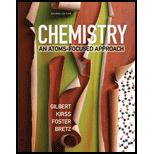
To calculate:
The rate law and the rate constant and rate of appearance of
Answer to Problem 13.64QA
Solution:
a)
b)
c)
Explanation of Solution
1) Concept:
There are two methods to determine the order of the reaction.
1. Graphical method - Plot the graph, and match it with the reference plot of order of reaction
2. Initial rate method - Determine the order of individual from ratio of two rate laws by keeping one constant.
In this problem, we are given the initial rates of the experiments. So we can use initial rate method to determine the order of the
We can calculate the rate of appearance from the rate of disappearance from the balanced reaction.
2) Given:
| Experiment | Initial rate (M/s) | ||
| 1 | 0.263 | 0.826 | 1.44 x 10-5 |
| 2 | 0.263 | 0.413 | 1.44 x 10-5 |
| 3 | 0.526 | 0.413 | 5.76 x 10-5 |
3) Formulae:
The general rate law equation for given reaction is
m and n are the order of the
4) Calculation
We are asked to determine the order of the reaction and rate constant from the initial rate and initial concentration of
The general rate law equation for given reaction is
We can calculate the m, n, and k from the initial rate values and initial concentrations.
a) To determine the value of m, we will select the pair of experiments with the same concentration of CO, so they can cancel out.
Experiment 3 and experiment 2 has the same value of CO. So, we can take the ratio of rate3 and rate 2 to calculate the order of NO2
So the order of reaction with respect toNO2is2.
Experiment 1 and experiment 2 have the same value of NO2. So, we can take the ratio of rate 1 and rate 2 to calculate the order of CO
So the order of reaction with respect to COis 0.
Therefore, the rate law for the given reaction is
b) Now we will calculate the k value at
Therefore, the rate constant at
c) To calculate the rate of appearance of CO2 , at
From the balanced reaction, rate of disappearance of NO2 = rate of appearance of CO2.
Conclusion:
We have calculated the rate law from the initial rate method and initial concentration given in the problem. Wehave also calculated the rate constant at
Want to see more full solutions like this?
Chapter 13 Solutions
CHEMISTRY:ATOMS-FOCUSED..-ACCESS
 ChemistryChemistryISBN:9781305957404Author:Steven S. Zumdahl, Susan A. Zumdahl, Donald J. DeCostePublisher:Cengage Learning
ChemistryChemistryISBN:9781305957404Author:Steven S. Zumdahl, Susan A. Zumdahl, Donald J. DeCostePublisher:Cengage Learning ChemistryChemistryISBN:9781259911156Author:Raymond Chang Dr., Jason Overby ProfessorPublisher:McGraw-Hill Education
ChemistryChemistryISBN:9781259911156Author:Raymond Chang Dr., Jason Overby ProfessorPublisher:McGraw-Hill Education Principles of Instrumental AnalysisChemistryISBN:9781305577213Author:Douglas A. Skoog, F. James Holler, Stanley R. CrouchPublisher:Cengage Learning
Principles of Instrumental AnalysisChemistryISBN:9781305577213Author:Douglas A. Skoog, F. James Holler, Stanley R. CrouchPublisher:Cengage Learning Organic ChemistryChemistryISBN:9780078021558Author:Janice Gorzynski Smith Dr.Publisher:McGraw-Hill Education
Organic ChemistryChemistryISBN:9780078021558Author:Janice Gorzynski Smith Dr.Publisher:McGraw-Hill Education Chemistry: Principles and ReactionsChemistryISBN:9781305079373Author:William L. Masterton, Cecile N. HurleyPublisher:Cengage Learning
Chemistry: Principles and ReactionsChemistryISBN:9781305079373Author:William L. Masterton, Cecile N. HurleyPublisher:Cengage Learning Elementary Principles of Chemical Processes, Bind...ChemistryISBN:9781118431221Author:Richard M. Felder, Ronald W. Rousseau, Lisa G. BullardPublisher:WILEY
Elementary Principles of Chemical Processes, Bind...ChemistryISBN:9781118431221Author:Richard M. Felder, Ronald W. Rousseau, Lisa G. BullardPublisher:WILEY





